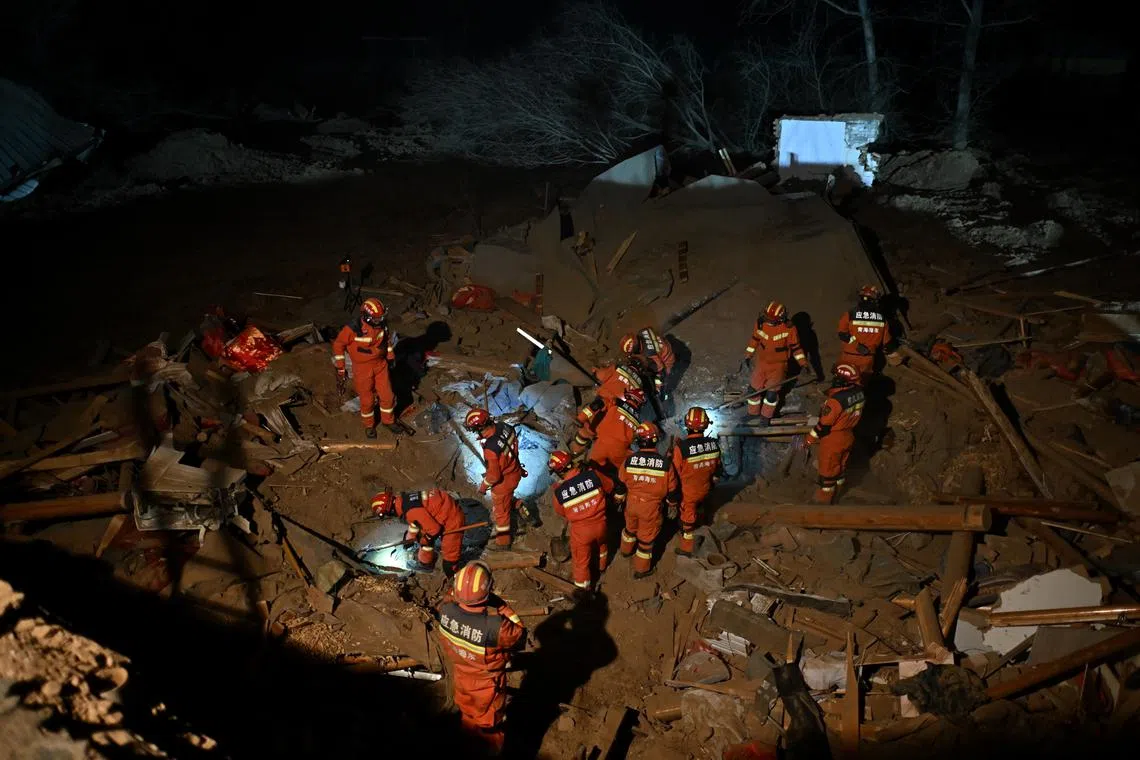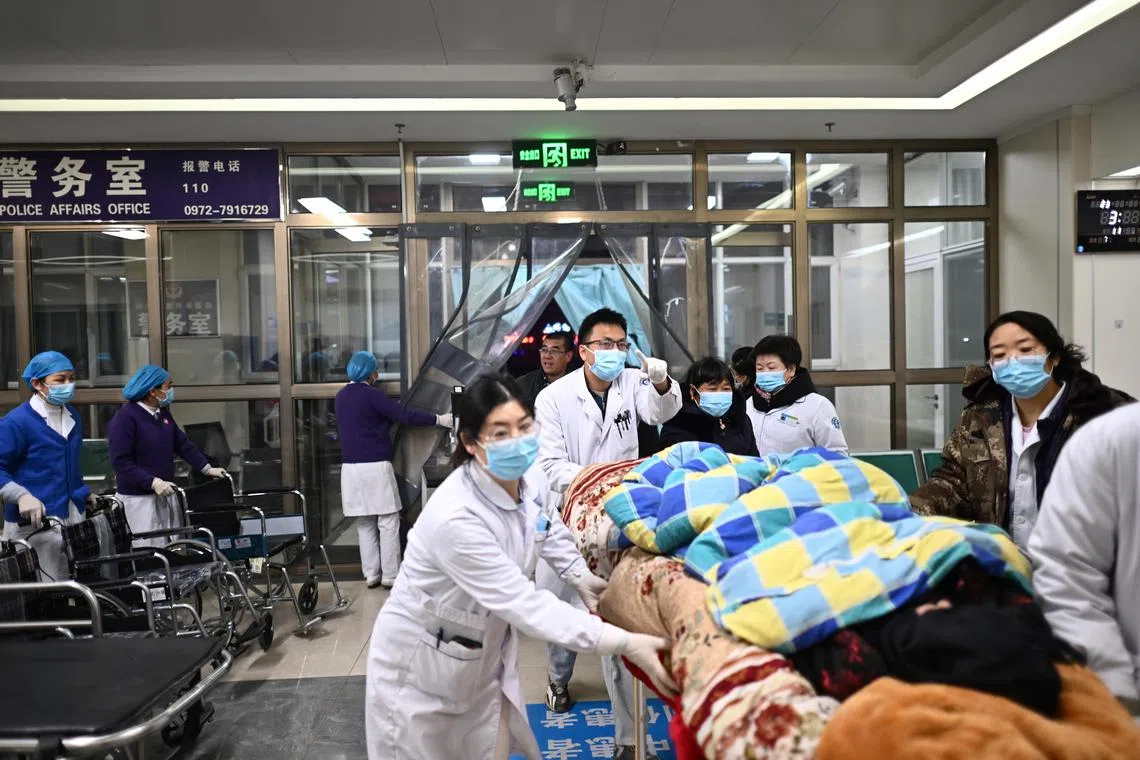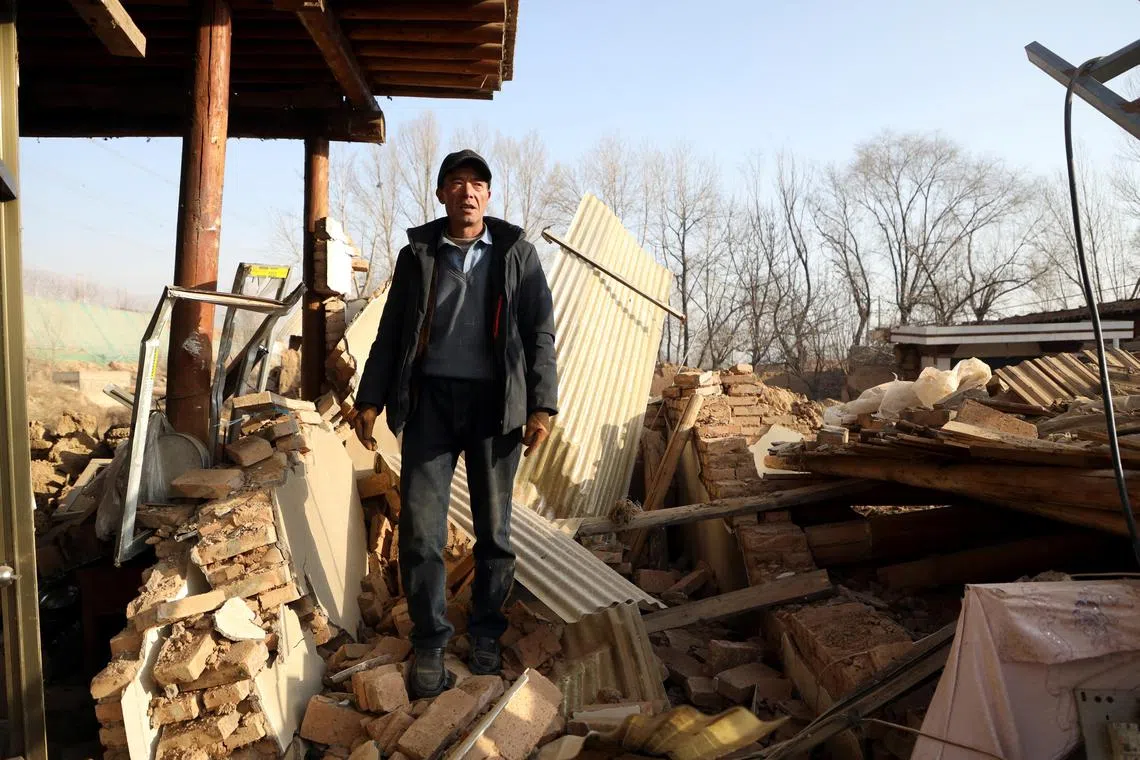Cascading waves of earth add to China’s Qinghai earthquake nightmare
Sign up now: Get ST's newsletters delivered to your inbox

Rescuers working in Caotan Village of Minhe Hui and Tu Autonomous County in Haidong city, Qinghai province, following an earthquake on Dec 19.
PHOTO: EPA-EFE
Follow topic:
Qinghai, China – More than two days after a magnitude-6.2 earthquake hit Jintian village, Qinghai province,
Mr Kong, 42, said: “The roof of my house looks as though it has split down the middle, but my family is fine.
“I heard that one member of a family, who is in his 80s, survived, but his two sons and grandson died in the quake. He is staying at a shelter and barely talks at present. This must be so painful for him.”
Behind Mr Kong, villagers resettled in shelters on open ground lined up at a temporary stall offering free beef noodles, peering expectantly at the boiling broth.
A rescuer wearing a yellow helmet said: “Under such circumstances, a bowl of hot beef noodles can solve many problems.”
The rescue worker gobbled down his noodles in just one minute, finishing off with a large sip of soup before dashing off to join his colleagues transporting and organising donated supplies – routine work they have performed day and night since the quake struck on Dec 18.
A scene of deep grief mixed with hope is unfolding across the remote village of Jintian, which has a population of about 1,800.
At least 135 people died and nearly 1,000 were injured
The village is situated about 16km from the quake’s epicentre in Gansu, separated by a stretch of the Yellow River.
In addition to the trauma caused by the quake, the village was hit by waves of earth churning like water that crushed houses in a phenomenon known as liquefaction, or sand boil.
Memories of the horrifying moment when layers of earth tumbled down from a nearby slope differ between the villagers, but they were all shocked and panicked by the incident.
“The mud, which appeared to be 4m to 5m deep, cascaded down and destroyed all the trees and buildings in its way,” Mr Kong said, pointing at a vast patch of land that had sunk at least 3m into the ground.
“Standing here again makes my hair stand on end,” he added.
Mr Kong was one of the first villagers to rush to houses that were submerged and buried under the mud, in an attempt to rescue those who were trapped.
“A child was trapped in the mud, so we grabbed his arm to pull him out, but we eventually failed. My memory of that night is something of a blur,” he said.

A person injured in an earthquake receiving treatment at a hospital in Minhe Hui and Tu Autonomous County of Haidong city, Qinghai, on Dec 19.
PHOTO: EPA-EFE
Mr Yang Delu, party chief of Jintian, was asleep when the quake woke him. “I ran outside, where the thick yellow mud looked as though it was 2m to 3m deep. I had no idea where it came from, so I immediately called higher authorities to seek assistance,” he said.
Mr Ma Guangjiong, a 67-year-old resident living on the perimeter of the village, who was watering his crops in a field when the quake struck, has listened to accounts of collapsed houses being buried deep in the mud.
“The sky somehow turned red at that moment. I thought that a nuclear bomb had been set off on the night of the earthquake. We knew people who died during the quake, because we worked together on the farmland for years. It is such a tragedy,” he said.
Some cracks appeared on the roof of Mr Ma’s house, but the main structure remains intact. He and his wife have spent two nights at a communal shelter.
“We also received a tent from the Red Cross that we can pitch in front of our house to accommodate my family and neighbours,” he said.
A total of 36 houses were demolished by the roiling earth, and most of the remaining homes were also damaged, making them unsafe.
“I think I will sleep in tents for the coming days. It is cold because of a lack of stoves and quilts, but I feel much safer staying there than sleeping in my house,” Mr Ma said.

Mr Du Xilu amid on the rubble near his damaged kitchen in Haidong, Qinghai province, on Dec 20, following the earthquake that rocked Gansu’s Jishishan county on Dec 18.
PHOTO: REUTERS
With the temperature likely to fall to minus 15 deg C in the evening, the mud and sediment blocking the roads are frozen into small mounds coated in thin ice. During the day, the ice shimmers in the sun.
Mr An Jun, an official with the Qinghai branch of the Red Cross Society of China, said diesel fuel that is supposed to withstand temperatures far below 20 deg C is frozen hard as a rock in the evening.
Red Cross officials erected 43 tents at a resettlement shelter on Dec 19 afternoon, Mr An said.
“The first night was excruciatingly cold. Each tent is designed to shelter four people, but we had to fit six in one of them due to the large number of displaced villagers and volunteers spending the night here. It was actually better that way, as more people huddling together create warmth,” he said.
More relief supplies and rescue workers are heading toward Jintian.
Mr Yang, the village party chief, said that as at Dec 21 afternoon, he had taken only a nap since the quake struck. Grabbing a discarded bottle of water from the roadside, he poured some of the contents over his face to refresh himself.
“I do not have time to sleep, chat or wash myself. Before night falls today, I must distribute jackets and quilts to the villagers,” he said.
Mr An said he expected Dec 21 night to be a little more comfortable, thanks to shipments of coal and heating stoves that arrived in the past two days.
“Local residents are used to setting up a heating stove in the centre of their homes to keep warm in winter. Putting them in a tent not only dispels the night chill to some extent, but also makes them feel more at home,” he said.
At around 5pm on Dec 21, a team of Red Cross workers who specialise in setting up sanitary toilets in disaster-stricken areas arrived in the village.
“There is so much more to do for the villagers affected by the quake, but I think that in the shelters, lives are slowly getting back on track, with villagers’ basic demands being met,” Mr An said.
In addition to collecting materials to withstand the cold, the main priority in Jintian on Dec 21 was clearing mud from the roads.
Officials did not give a specific time for the mud-clearing work to be completed. The only main road leading to the village was closed to most vehicles on Dec 21, except for trucks tasked with removing the mud.
At least 10 cranes and excavators were stationed near mud-covered areas. Every few minutes, a truck loaded with mud and debris was driven out of the village.
Mr Han Chenglu, who lives in Bazigou village, Qinghai, about 100km from Jintian, is one of six cooks and staff members working together at the beef noodle stall.
“Seeing these quake-stricken communities in person is completely different from reading about them in the news. Some villagers still have tears in their eyes when I hand them a bowl of noodles,” he said.
The stall opens at around 10am and does not close until all the villagers have gone to sleep at night, he said, adding: “We are striving to make a small contribution to help those affected by the quake.” CHINA DAILY/ASIA NEWS NETWORK

